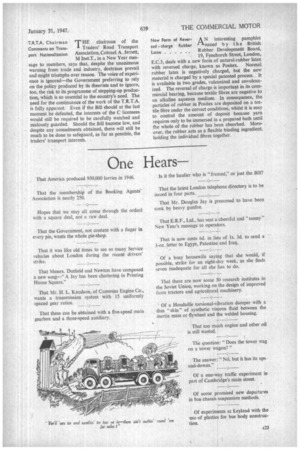Passing Comments
Page 24

Page 25

If you've noticed an error in this article please click here to report it so we can fix it.
Oxford's Mayor DeE Mayor of Oxford, cries Long distance Councilor E. A. Smewin, Coach Services . has taken upon himself strongly to criticize the employment of long-distance coaches operating from Oxford Speaking at the annual dinner of the Oxford branch of the G.W.R. road motor engineer's department, he said he must be careful what he said because there was always someone waiting around the corner to challenge any statement he made. He was quite right. We challenge him not only for the reason that he decried road services, which have done a great deal to help travellers, but because in his public office, in which he is, presumably, supposed to represent all interests.he chose the occasion to criticize severely an important section. There are not so many coaches on the road as to add greatly to congestion, and, in any case, they provide large numbers of people with enjoyable travel at reasonable charges.
Can We Make More IT is not often that we venUs e of Fibrous iture into the realms of Tissue? anatomy, but we are tempted to compare the strength of the fibrous tissues of the body with that of other materials. The former ranges from 6,000 to .11,000 lb. per sq in.; . annealed copper is about 10,000 lb., ind pure aluminium 5,000 lb. The strength of catgut is, of course, proverbial. It is used largely by fishermen, and for achieving the sound vibrations in certain musical instruments of the string type. T.R.T.A. Chairman Comments on Transport Nationalization THE chairman of the Traders' Road Transport Association, Colonel A. Jerrett, M Inst.T., in a New Year message to members, says that, despite the unanimous warning from trade and industry, doctrines prevail and might triumphs over reason. The voice of experience is ignored—the Government preferring to rely on the policy produced by its theorists and to ignore, too, the risk to its programme of stepping-up production, which is so essential to the country's need. The need for the continuance of the work of the T.R.T.A. is fully apparent. Even if the Bill should at the last moment be defeated, the interests of the C licensees would still be required to be carefully watched and zealously guarded. Should the Bill become law, and despite any amendments obtained, there will still be much to be done to safeguard, as far as possible, the traders' transport interests. New Form of ReverA N interesting pamphlet sed charge Rubber I-1 issued by the British Latex Rubber Development Board, 19, Fenchurch Street, London, E.C.3, deals with a new form of natural-rubber latex with reversed charge, known as Positex. Normal rubber latex is negatively charged, but the new material is charged by a special patented process. It is available in two grades, vulcanized and unvulcanized. The reversal of charge is important in its commercial bearing, because textile fibres are negative to an alkaline aqueous medium. In consequence, the particles of rubber in Positex are deposited on a textile fibre under the correct conditions, whilst it is easy to control the amount of deposit because yarn requires only to be immersed in a prepared bath until the whole of the rubber has been absorbed. Moreover, the rubber acts as a flexible binding ingredient, holding the individual fibres together.












































































